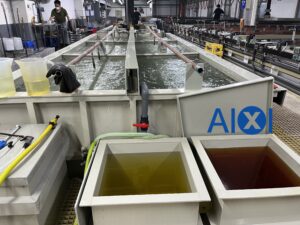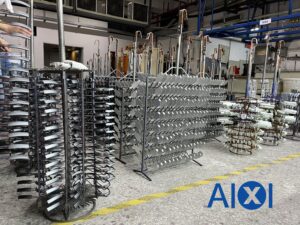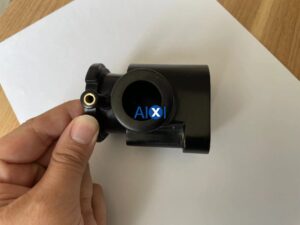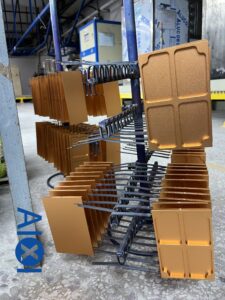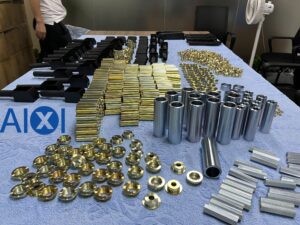All post-processing adds to part production costs and production time, but the right surface finish can go a long way toward making the original design vision a reality. Metal surface treatments for CNC machined parts typically include various mechanical processes such as tumbling, brushing, and sandblasting, but metal parts can also have chemical surface treatments such as passivation and galvanizing.
The main role of chemical surface treatment:
Remove defects on workpiece surface
Change the conductivity level of parts
Extend the service life of parts
Improve the wear resistance and corrosion resistance of parts
In actual operation, different chemical surface treatment methods may not be compatible with all metal materials. In fact, each chemical surface treatment is generally compatible with specific materials and has its own advantages and disadvantages. Therefore, when choosing a surface treatment for a part, you also need to consider compatible materials and end uses in order to select the surface treatment that best meets your design goals. Background factors to consider when making your selection include the following:
- Final use environment of finished parts
- Whether conductive or insulating properties are required
- How much weight does it need to bear?
- How much wear and tear is required?
- Tolerance requirements
- Color and transparency requirements
- Surface finish standard
- Any other relevant or required attributes
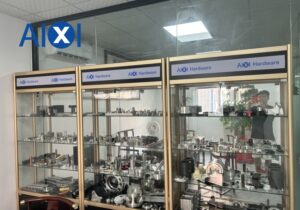
Anodizing: aluminum, titanium and other non-ferrous metals
Passivation: stainless steel
Black Oxide: Steel, Stainless Steel, Copper and Other Metals
Chemical coating (chromate conversion coating): Aluminum
Electropolishing: aluminum, steel, stainless steel, copper, titanium, brass, bronze, beryllium and other metals
Electroplating: cadmium, chromium, copper, gold, nickel, silver, tin aluminum, steel and other metals
Chrome plating (a type of electroplating): aluminum, steel, stainless steel, nickel alloys, titanium, copper and other metals
Polytetrafluoroethylene (Teflon™) coating: aluminum, steel and other metals
Electroless Nickel Plating: Aluminum, Steel and Stainless Steel
Galvanized: steel
How different surface treatments work
Anodizing: Anodizing is a common aluminum surface treatment that thickens the natural oxide layer on the surface of the part, forming an anodized film that enhances protection and improves aesthetics. For aluminum, in order to form the protective anodized layer, the part needs to be immersed in an acidic electrolyte solution and then a cathode (negatively charged electrode) is applied to cause the solution to release hydrogen gas. At the same time, the aluminum component (the positively charged anode) releases oxygen, forming a protective oxide layer on its surface. After a part is anodized, its surface will have tiny pores that must be sealed with a chemical solution to prevent corrosion and the build-up of contaminants.
There are three different types of anodization:
Type I (chromic acid anodizing) produces the thinnest oxide layer, meaning it does not change the dimensions of the part. Type I anodized components will appear grayer in color and will not absorb other colors well.
Type II (boron sulfate anodized) has better paint adhesion and is slightly thicker than Type I. With Type II anodizing, you can easily create blue, red, gold, black or green anodized parts.
Type III (hard sulfuric acid anodization) is the most common form of anodization. It has the clearest finish, which means it can be used with more colors. It is worth noting that Type III anodization results in a slightly thicker f. Prettier than Type II anodization.
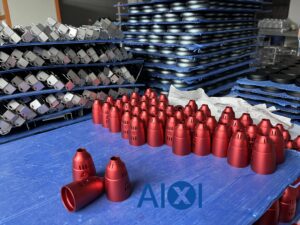
Passivation: During the passivation process, parts are immersed in an acid-based solution (nitric or citric acid) to remove iron and rust from their surfaces without disturbing the chromium. Applying acid to stainless steel removes any free iron or iron compounds from its surface, leaving behind a layer composed of chromium (and sometimes nickel). When exposed to air, these materials react with oxygen to form a protective oxide layer. Nitric acid has traditionally been the typical choice for passivation, but citric acid has become increasingly popular recently because it reduces cycle times and is safer and more environmentally friendly
It is important to remember that passivation can extend the production time of a part. Before passivating a part, it must be cleaned to remove any grease, dirt, or other contaminants, then rinsed and soaked (or sprayed). While immersion is the most common passivation method because it provides even coverage and can be done quickly, acid sprays can also be used as an alternative.
Black Oxide Coating: Process is a surface treatment of ferrous metals such as steel, stainless steel, and copper that involves immersing the part in an oxide bath to form a layer of magnetite (Fe3O4) that provides mild corrosion resistance.
There are three types of black oxide coatings:
- Thermal Black Oxide: The thermal black oxide coating process involves immersing the part in a hot bath of sodium hydroxide, nitrite, and nitrate to turn its surface into magnetite. After cleaning, the parts need to be soaked in alkaline cleaners, water and caustic soda, and then coated with oil or wax to achieve the desired aesthetic effect.
- Mid-temperature black oxide coating: Mid-temperature black oxide coating is very similar to hot black oxide coating. The main difference is that coated parts turn black at lower temperatures (90 – 120 °C). Since this temperature is below the boiling point of sodium and nitrate solutions, there is no need to worry about corrosive fumes.
- Cold Black Oxide: While hot and medium temperature black oxide coatings involve oxide conversion, cool black oxide relies on deposited copper selenium to transform the part. Cool black oxide is easier to apply, but rubs off faster and is less resistant to abrasion.
.
Chemical film: Also known as chromate conversion coating, is a thin coating often used on aluminum to prevent corrosion and improve adhesion of adhesives and paints. Chemical film finishes have proprietary formulas, but chromium is the main ingredient in each variety. Chemical film topcoats can be applied by spraying, dipping or brushing, and depending on the product and formulation, the color can be yellow, tan, gold or clear.
Electropolishing: is an electrochemical finishing process commonly used to remove a thin layer of material from steel, stainless steel, and similar alloys. During electropolishing, the part is immersed in a chemical solution and an electric current is applied to dissolve its surface layers. Various parameters affect the finish of the part, including the chemical composition of the electrolyte solution, temperature and exposure time of the part. Electropolishing typically removes 0.0002 to 0.0003 inches from an object’s surface, leaving a smooth, shiny, and clean material.
Electroplating: It is actually the reverse process of electrolytic polishing. Rather than removing a layer of metal to obtain a finished surface, electroplating deposits an additional outer layer, thereby increasing the thickness of the part. Plating creates smooth parts that will wear less over time due to additional protection against corrosion, discoloration, impact and heat.
Chrome plating: is a type of electroplating that involves adding a thin layer of chromium to a metal part to increase its surface hardness or corrosion resistance. Adding a layer of chromium can make the part easier to clean and improve its aesthetics, and almost all metal parts can be chromium plated, including aluminum, stainless steel, and titanium. The chrome plating process typically involves degreasing, manual cleaning and pre-treatment before the parts are placed in the chrome bath. The part must then remain in the tank long enough for the chromium layer to reach the desired thickness. Chrome plating is a relatively expensive finishing process because the process consumes electricity and involves multiple steps.
Polytetrafluoroethylene (PTFE) coating: It is available in powder and liquid forms and is applied directly to the surface of the workpiece and is widely used throughout industry. Some PTFE applications require only one coat, but others require a primer and topcoat to ensure maximum protection.
Electroless nickel plating: refers to adding a protective layer of nickel alloy to metal parts. In contrast to electroplating processes, which involve electric current, electroless nickel plating involves depositing a layer of a nickel alloy (usually nickel phosphorus) on the part using a nickel bath and a chemical reducing agent such as sodium hypophosphite. Nickel alloys deposit uniformly, even on complex parts with holes and slots. Electroless nickel plating is not suitable for rough, uneven, or poorly machined surfaces, and parts need to be cleaned of soap, oil, and dirt before the plating process can begin.
Different types of electroless nickel coatings are classified based on the weight percentage of phosphorus in the alloy. Different levels of phosphorus content also provide different levels of corrosion resistance and hardness:
Low phosphorus nickel (2 – 4% phosphorus): Low phosphorus electroless nickel plating has a coating hardness between 58 and 62 Rc and has high wear resistance. It has a high melting point and good corrosion resistance under alkaline conditions. Low phosphorus electroless nickel coatings are subject to compressive stress and are generally more expensive than medium and high phosphorus nickel.
Medium phosphorus nickel (5 – 9% phosphorus): Medium phosphorus nickel plating is between low phosphorus nickel and high phosphorus nickel. It is corrosion resistant in alkaline and acidic environments and has a fast deposition rate (18 to 25 µm per hour). The coating hardness of medium phosphorus nickel can be any value between 45 and 57 Rc, and the coating can reach 65 to 70 Rc through heat treatment.
High phosphorus nickel (>10% phosphorus): Because the high phosphorus deposit of electroless nickel plating is amorphous, the parts will not show phase boundaries or grains, thus improving their corrosion resistance, making them ideal for outdoor or extreme applications. environment. High phosphorus electroless nickel also offers ductility, high thickness, resistance to contamination, and makes your final product easier to polish or weld.
Galvanizing: There are several different types, electro-galvanizing requires an electric current to coat the part with a thin layer of zinc, while hot-dip galvanizing requires the part to be immersed in a hot zinc bath. Electro-galvanizing is the cheaper process, but hot-dip galvanizing is better suited for parts that will be used in harsh environments or will experience a lot of wear and tear.
After the galvanizing process, parts can undergo a secondary treatment to enhance protection and improve performance. The ASTM B633 standard is the most widely used galvanizing standard and includes four types of galvanizing:
Type I: There is no complementary treatment for Type I.
Type II: Type II involves color chromate treatment.
Type III: Type III is treated with colorless chromate.
Type IV: Type IV is treated with phosphate conversion.
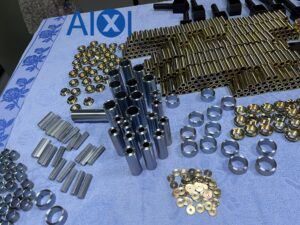
Advantages of different surface treatments for CNC parts:
Anodized: Parts are durable and resistant to corrosion and wear, reducing maintenance costs. The anodized layer is non-conductive and fully integrated with the aluminum substrate, so it won’t chip or peel like plating and paint. In addition to being sealed, the porous anodized layer can be painted or stained and is also more environmentally friendly because the anodized surface is non-toxic and chemically stable. Anodizing increases the surface hardness of the part.
Passivation: This popular metal surface treatment process prevents corrosion of stainless steel parts, helping them maintain cleanliness, performance and appearance. Not only are passivated parts more resistant to rust and therefore better suited for outdoor use, but they are also less likely to pit, last longer, look better, and are more functional.
Black Oxide Coating: Parts will have better corrosion and rust resistance, be less reflective, and have a longer life cycle. An oil or wax coating can increase water resistance and also prevent harmful substances from reaching the interior of the metal, making the part easier to clean.
Chemical Film: While other finishes reduce thermal and electrical conductivity, chemical film finishes allow aluminum to maintain its electrically conductive properties. Chemical films are also relatively inexpensive and, as mentioned above, provide a good base for painting and priming (for the added time-saving benefit).
Electropolishing: Its main advantages include improved corrosion resistance, extended part life, improved fatigue strength, reduced friction coefficient, reduced surface roughness, and elimination of surface defects such as burrs and microcracks.
Electroplating: can increase the adhesion between the substrate and its additional outer coating and, depending on the type of metal used, can make your part magnetic or conductive.
Polytetrafluoroethylene (PTFE) coating: Has a non-stick surface, low coefficient of friction and is highly wear-resistant. Because PTFE coatings have low porosity and low surface energy, coated parts are resistant to water, oil, and chemicals. PTFE can also withstand temperatures up to 500°F, is easy to clean, and has excellent electrical insulation and chemical resistance.
Nickel plating: Has higher resistance to oxygen, carbon dioxide, salt water and hydrogen sulfide corrosion. Nickel plated parts also have good hardness and wear resistance.
Galvanizing, or zinc chromate, is a popular chemical surface treatment that protects steel components from moisture and corrosion. Galvanized products extend service life, improve aesthetics, and have a more uniform appearance. Galvanizing can also change the color of the part to silvery blue, yellow, black or green. Another significant benefit of galvanizing is that it protects the surface of the part for many years: even if the coating is scratched, the zinc will react with the atmosphere and oxidize quickly.
Disadvantages of different surface treatments for CNC parts:
Anodizing: Anodizing metal changes the dimensions of the part, so the oxide layer needs to be considered when determining dimensional tolerances, or a chemical or physical mask may be used to ensure that specific areas of the part remain untreated. Anodized components are not processed in the same batch and achieving a true color match may be difficult or fading may occur. Anodizing a metal part increases its electrical and thermal resistance.
Chemical Film: It is prone to scratches, scuffs, and other surface damage, so it is not ideal for projects where aesthetics is a primary concern.
Electropolishing: It is faster and cheaper than manual polishing, but it still takes time and does not remove 100% of rough surface defects.
Electroplating: Not environmentally friendly as it produces hazardous waste that, if not disposed of properly, can seriously pollute the environment. Plating is also relatively expensive and can be very time-consuming due to the metals and chemicals required for plating (as well as other necessary materials and equipment), especially when the part requires multiple layers.
Polytetrafluoroethylene (PTFE) Coating: Although the PTFE coating process is popular across industries, it is relatively costly and not as durable as other chemical finishing options.
Nickel Plating: Accumulation of contaminants in the nickel plating bath, increased phosphorus content and subsequent reduction in plating rate. The wrong temperature or pH can cause coating quality issues such as pitting, dullness and roughness.
Galvanizing: Zinc is chemically sensitive to acids and alkalis, so galvanizing may not be sufficient for parts in wet or extremely wet environments.
Application of different surface treatment methods of CNC parts:
Anodizing: This process provides a high level of dimensional control, making anodizing particularly popular in the aerospace and construction sectors. In addition to these industries, anodized metal parts are widely used in a variety of applications, including curtain walls, escalators, laptops, and more.
Passivation: Used in a variety of industries, from the medical industry where sterilization and longevity are critical, to the aerospace industry where companies seek high steel quality and tight dimensional tolerances.
Black Oxide Coating: Adds thickness, making it ideal for drills, screwdrivers, and other tools that require a sharp edge that won’t dull over time.
Coated with polytetrafluoroethylene (PTFE): Due to its chemical resistance and non-stick properties, PTFE is commonly used to coat fuel lines and circuit board insulation in computers, microwave ovens, smartphones, and air conditioners. It is also commonly used to coat medical tools and equipment and cookware.
Chemical finishing offers a variety of methods to achieve the required surface quality and performance levels of parts, but not every finishing process is suitable for every material and end use. To determine which chemical surface treatment is right for your part, you need a deep understanding of key factors, such as how much corrosion resistance the final part needs corrosion, friction and wear resistance, the environment in which it is used, and its required conductive or insulating properties. Given the importance of these considerations, it’s worth looking for a manufacturing partner to help you choose the most suitable surface treatment and ensure it delivers the best possible quality and cost efficiency. If necessary, please contact AIXI to resolve your doubts and develop a solution that best suits product expectations.

 English
English Deutsch
Deutsch Français
Français 日本語
日本語
